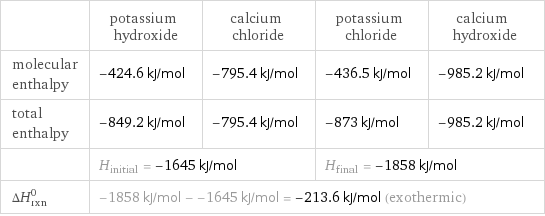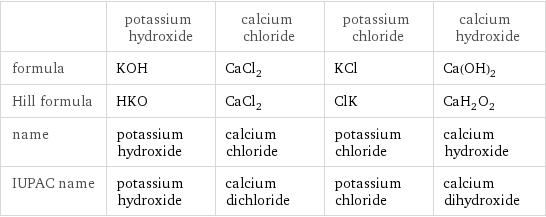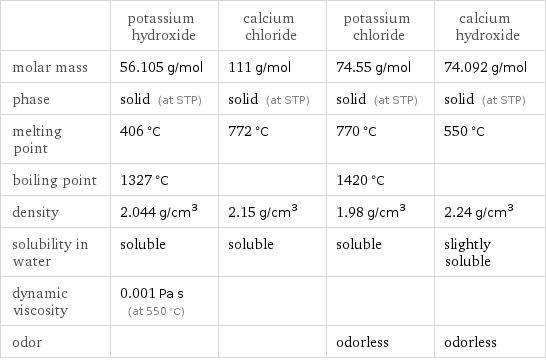Input interpretation

KOH potassium hydroxide + CaCl_2 calcium chloride ⟶ KCl potassium chloride + Ca(OH)_2 calcium hydroxide
Balanced equation

Balance the chemical equation algebraically: KOH + CaCl_2 ⟶ KCl + Ca(OH)_2 Add stoichiometric coefficients, c_i, to the reactants and products: c_1 KOH + c_2 CaCl_2 ⟶ c_3 KCl + c_4 Ca(OH)_2 Set the number of atoms in the reactants equal to the number of atoms in the products for H, K, O, Ca and Cl: H: | c_1 = 2 c_4 K: | c_1 = c_3 O: | c_1 = 2 c_4 Ca: | c_2 = c_4 Cl: | 2 c_2 = c_3 Since the coefficients are relative quantities and underdetermined, choose a coefficient to set arbitrarily. To keep the coefficients small, the arbitrary value is ordinarily one. For instance, set c_2 = 1 and solve the system of equations for the remaining coefficients: c_1 = 2 c_2 = 1 c_3 = 2 c_4 = 1 Substitute the coefficients into the chemical reaction to obtain the balanced equation: Answer: | | 2 KOH + CaCl_2 ⟶ 2 KCl + Ca(OH)_2
Structures

+ ⟶ +
Names

potassium hydroxide + calcium chloride ⟶ potassium chloride + calcium hydroxide
Reaction thermodynamics
Enthalpy

| potassium hydroxide | calcium chloride | potassium chloride | calcium hydroxide molecular enthalpy | -424.6 kJ/mol | -795.4 kJ/mol | -436.5 kJ/mol | -985.2 kJ/mol total enthalpy | -849.2 kJ/mol | -795.4 kJ/mol | -873 kJ/mol | -985.2 kJ/mol | H_initial = -1645 kJ/mol | | H_final = -1858 kJ/mol | ΔH_rxn^0 | -1858 kJ/mol - -1645 kJ/mol = -213.6 kJ/mol (exothermic) | | |
Gibbs free energy

| potassium hydroxide | calcium chloride | potassium chloride | calcium hydroxide molecular free energy | -379.4 kJ/mol | -748.8 kJ/mol | -408.5 kJ/mol | -897.5 kJ/mol total free energy | -758.8 kJ/mol | -748.8 kJ/mol | -817 kJ/mol | -897.5 kJ/mol | G_initial = -1508 kJ/mol | | G_final = -1715 kJ/mol | ΔG_rxn^0 | -1715 kJ/mol - -1508 kJ/mol = -206.9 kJ/mol (exergonic) | | |
Equilibrium constant
![Construct the equilibrium constant, K, expression for: KOH + CaCl_2 ⟶ KCl + Ca(OH)_2 Plan: • Balance the chemical equation. • Determine the stoichiometric numbers. • Assemble the activity expression for each chemical species. • Use the activity expressions to build the equilibrium constant expression. Write the balanced chemical equation: 2 KOH + CaCl_2 ⟶ 2 KCl + Ca(OH)_2 Assign stoichiometric numbers, ν_i, using the stoichiometric coefficients, c_i, from the balanced chemical equation in the following manner: ν_i = -c_i for reactants and ν_i = c_i for products: chemical species | c_i | ν_i KOH | 2 | -2 CaCl_2 | 1 | -1 KCl | 2 | 2 Ca(OH)_2 | 1 | 1 Assemble the activity expressions accounting for the state of matter and ν_i: chemical species | c_i | ν_i | activity expression KOH | 2 | -2 | ([KOH])^(-2) CaCl_2 | 1 | -1 | ([CaCl2])^(-1) KCl | 2 | 2 | ([KCl])^2 Ca(OH)_2 | 1 | 1 | [Ca(OH)2] The equilibrium constant symbol in the concentration basis is: K_c Mulitply the activity expressions to arrive at the K_c expression: Answer: | | K_c = ([KOH])^(-2) ([CaCl2])^(-1) ([KCl])^2 [Ca(OH)2] = (([KCl])^2 [Ca(OH)2])/(([KOH])^2 [CaCl2])](../image_source/a7d321b9c3b77d4b1b11f10a4fabe60e.png)
Construct the equilibrium constant, K, expression for: KOH + CaCl_2 ⟶ KCl + Ca(OH)_2 Plan: • Balance the chemical equation. • Determine the stoichiometric numbers. • Assemble the activity expression for each chemical species. • Use the activity expressions to build the equilibrium constant expression. Write the balanced chemical equation: 2 KOH + CaCl_2 ⟶ 2 KCl + Ca(OH)_2 Assign stoichiometric numbers, ν_i, using the stoichiometric coefficients, c_i, from the balanced chemical equation in the following manner: ν_i = -c_i for reactants and ν_i = c_i for products: chemical species | c_i | ν_i KOH | 2 | -2 CaCl_2 | 1 | -1 KCl | 2 | 2 Ca(OH)_2 | 1 | 1 Assemble the activity expressions accounting for the state of matter and ν_i: chemical species | c_i | ν_i | activity expression KOH | 2 | -2 | ([KOH])^(-2) CaCl_2 | 1 | -1 | ([CaCl2])^(-1) KCl | 2 | 2 | ([KCl])^2 Ca(OH)_2 | 1 | 1 | [Ca(OH)2] The equilibrium constant symbol in the concentration basis is: K_c Mulitply the activity expressions to arrive at the K_c expression: Answer: | | K_c = ([KOH])^(-2) ([CaCl2])^(-1) ([KCl])^2 [Ca(OH)2] = (([KCl])^2 [Ca(OH)2])/(([KOH])^2 [CaCl2])
Rate of reaction
![Construct the rate of reaction expression for: KOH + CaCl_2 ⟶ KCl + Ca(OH)_2 Plan: • Balance the chemical equation. • Determine the stoichiometric numbers. • Assemble the rate term for each chemical species. • Write the rate of reaction expression. Write the balanced chemical equation: 2 KOH + CaCl_2 ⟶ 2 KCl + Ca(OH)_2 Assign stoichiometric numbers, ν_i, using the stoichiometric coefficients, c_i, from the balanced chemical equation in the following manner: ν_i = -c_i for reactants and ν_i = c_i for products: chemical species | c_i | ν_i KOH | 2 | -2 CaCl_2 | 1 | -1 KCl | 2 | 2 Ca(OH)_2 | 1 | 1 The rate term for each chemical species, B_i, is 1/ν_i(Δ[B_i])/(Δt) where [B_i] is the amount concentration and t is time: chemical species | c_i | ν_i | rate term KOH | 2 | -2 | -1/2 (Δ[KOH])/(Δt) CaCl_2 | 1 | -1 | -(Δ[CaCl2])/(Δt) KCl | 2 | 2 | 1/2 (Δ[KCl])/(Δt) Ca(OH)_2 | 1 | 1 | (Δ[Ca(OH)2])/(Δt) (for infinitesimal rate of change, replace Δ with d) Set the rate terms equal to each other to arrive at the rate expression: Answer: | | rate = -1/2 (Δ[KOH])/(Δt) = -(Δ[CaCl2])/(Δt) = 1/2 (Δ[KCl])/(Δt) = (Δ[Ca(OH)2])/(Δt) (assuming constant volume and no accumulation of intermediates or side products)](../image_source/9ee3b2ae1de946e23a1ea4dcaa598748.png)
Construct the rate of reaction expression for: KOH + CaCl_2 ⟶ KCl + Ca(OH)_2 Plan: • Balance the chemical equation. • Determine the stoichiometric numbers. • Assemble the rate term for each chemical species. • Write the rate of reaction expression. Write the balanced chemical equation: 2 KOH + CaCl_2 ⟶ 2 KCl + Ca(OH)_2 Assign stoichiometric numbers, ν_i, using the stoichiometric coefficients, c_i, from the balanced chemical equation in the following manner: ν_i = -c_i for reactants and ν_i = c_i for products: chemical species | c_i | ν_i KOH | 2 | -2 CaCl_2 | 1 | -1 KCl | 2 | 2 Ca(OH)_2 | 1 | 1 The rate term for each chemical species, B_i, is 1/ν_i(Δ[B_i])/(Δt) where [B_i] is the amount concentration and t is time: chemical species | c_i | ν_i | rate term KOH | 2 | -2 | -1/2 (Δ[KOH])/(Δt) CaCl_2 | 1 | -1 | -(Δ[CaCl2])/(Δt) KCl | 2 | 2 | 1/2 (Δ[KCl])/(Δt) Ca(OH)_2 | 1 | 1 | (Δ[Ca(OH)2])/(Δt) (for infinitesimal rate of change, replace Δ with d) Set the rate terms equal to each other to arrive at the rate expression: Answer: | | rate = -1/2 (Δ[KOH])/(Δt) = -(Δ[CaCl2])/(Δt) = 1/2 (Δ[KCl])/(Δt) = (Δ[Ca(OH)2])/(Δt) (assuming constant volume and no accumulation of intermediates or side products)
Chemical names and formulas

| potassium hydroxide | calcium chloride | potassium chloride | calcium hydroxide formula | KOH | CaCl_2 | KCl | Ca(OH)_2 Hill formula | HKO | CaCl_2 | ClK | CaH_2O_2 name | potassium hydroxide | calcium chloride | potassium chloride | calcium hydroxide IUPAC name | potassium hydroxide | calcium dichloride | potassium chloride | calcium dihydroxide
Substance properties

| potassium hydroxide | calcium chloride | potassium chloride | calcium hydroxide molar mass | 56.105 g/mol | 111 g/mol | 74.55 g/mol | 74.092 g/mol phase | solid (at STP) | solid (at STP) | solid (at STP) | solid (at STP) melting point | 406 °C | 772 °C | 770 °C | 550 °C boiling point | 1327 °C | | 1420 °C | density | 2.044 g/cm^3 | 2.15 g/cm^3 | 1.98 g/cm^3 | 2.24 g/cm^3 solubility in water | soluble | soluble | soluble | slightly soluble dynamic viscosity | 0.001 Pa s (at 550 °C) | | | odor | | | odorless | odorless
Units
